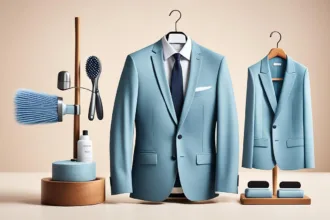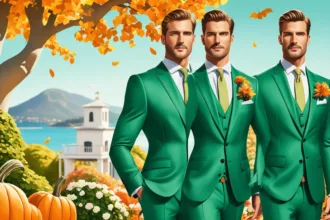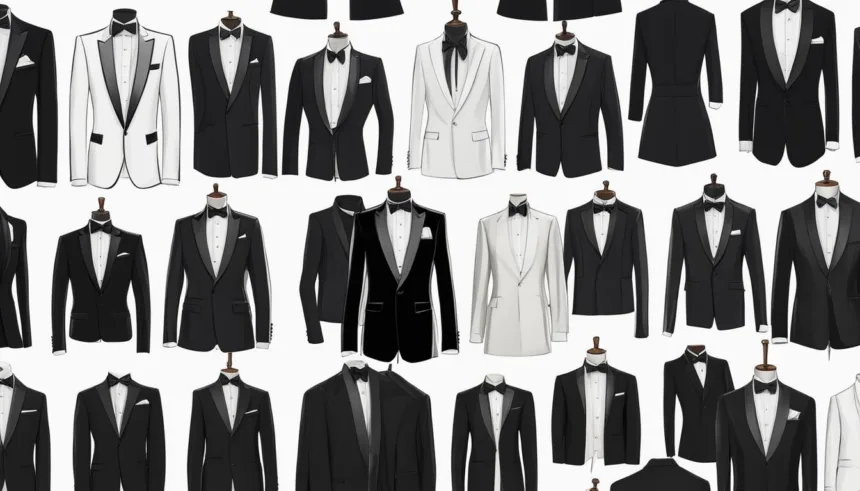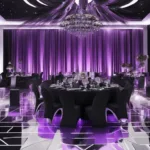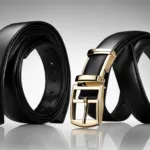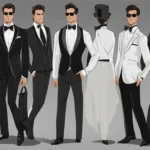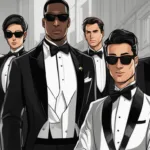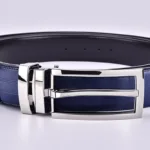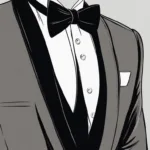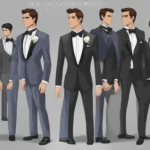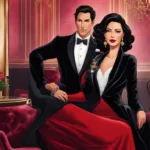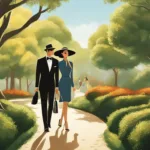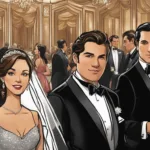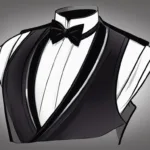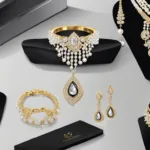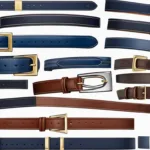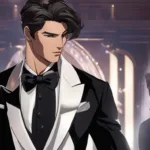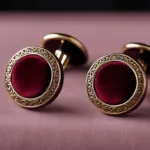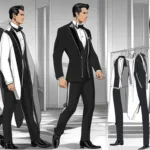The allure of classic black tie tuxedo styles is unrivaled, with timeless refinement and traditional tuxedo elegance at the forefront of their charm. These sartorial masterpieces have played an essential role in defining the sophistication of the wearer, providing an impeccable balance between form and function. Throughout history, style icons like Cary Grant have showcased the powerful impact a well-tailored tuxedo can have on a man’s appearance, making these garments not just clothing but symbols of style and stature.
With a nod to the rich history of tuxedo fashion, this article delves into the world of classic black tie attire, revealing key design elements and the enduring importance of traditional tuxedo dress codes. Join us as we uncover the significance of these timeless garments and how they continue to captivate hearts and minds with their everlasting appeal.
Key Takeaways
- Classic black tie tuxedo styles epitomize timeless refinement and elegance.
- Traditional tuxedo design is rooted in the balance between form and function, highlighting the wearer’s sophistication.
- Celebrated style icons like Cary Grant have showcased the power of well-tailored tuxedos to elevate a man’s appearance.
- Detailed analysis of design elements and dress codes reveals the enduring importance of traditional tuxedo styles.
- Classic black tie attire remains a symbol of taste and distinction in a constantly evolving world of fashion.
The Enduring Allure of Classic Black Tie Tuxedo Styles
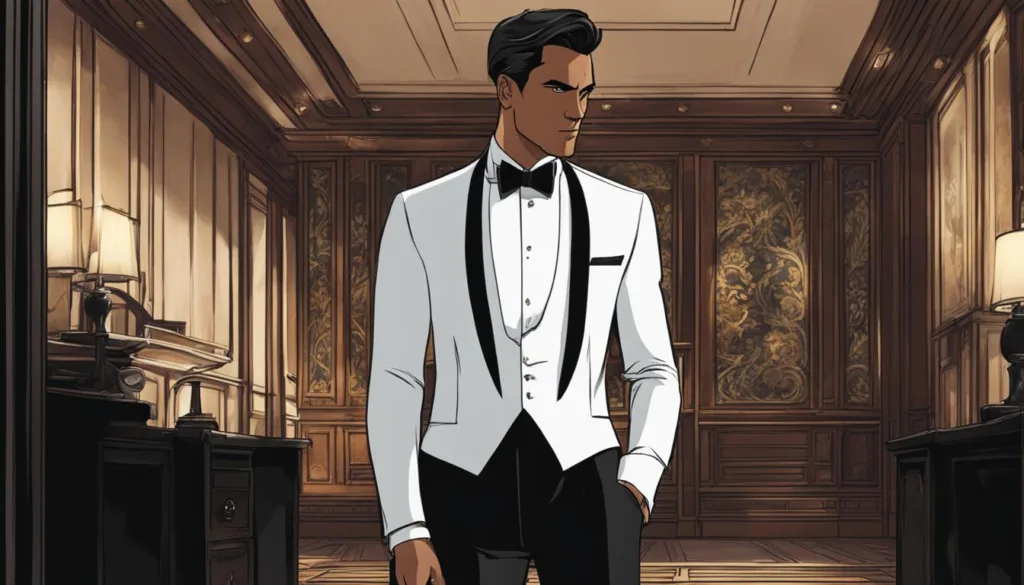
The captivating appeal of classic black tie tuxedo styles lies in their rich history and continuous evolution, a journey that saw its most defining moments during the Depression era. It was during this time that the tuxedo established its own identity, shedding its informal associations with white tie outfits and embracing a new level of refinement.
The History and Evolution of the Tuxedo
Throughout its historical progression, the classic tuxedo has experienced significant sartorial advancements. It was in the Depression era that essential components, such as the black waistcoat, the formal turn-down collar shirt, and the versatile cummerbund, became integral elements of the ensemble. This period also saw the emergence of renowned figures like Cary Grant, whose impeccable style in films like “Indiscreet” demonstrated the transformative effect of a tuxedo in enhancing a man’s silhouette and earning admiration from onlookers. This evolution highlights the fact that classic black tie tuxedos are not merely garments, but rather a testament to the intricate relationship between form and function.
Key Characteristics of Timeless Tuxedo Design
What makes the quintessential tuxedo truly timeless are several essential elements that have consistently contributed to its undeniable sophistication. These include simplistic elegance, a structured fit, and the presence of distinctive yet discreet accessories that harmonize with the ensemble’s refinement. By understanding and honoring these characteristics, individuals can curate a black tie event style guide and create a memorable outfit that speaks to the rich history of the classic tuxedo while adding their personal touch.
Decoding the Traditional Tuxedo Dress Code
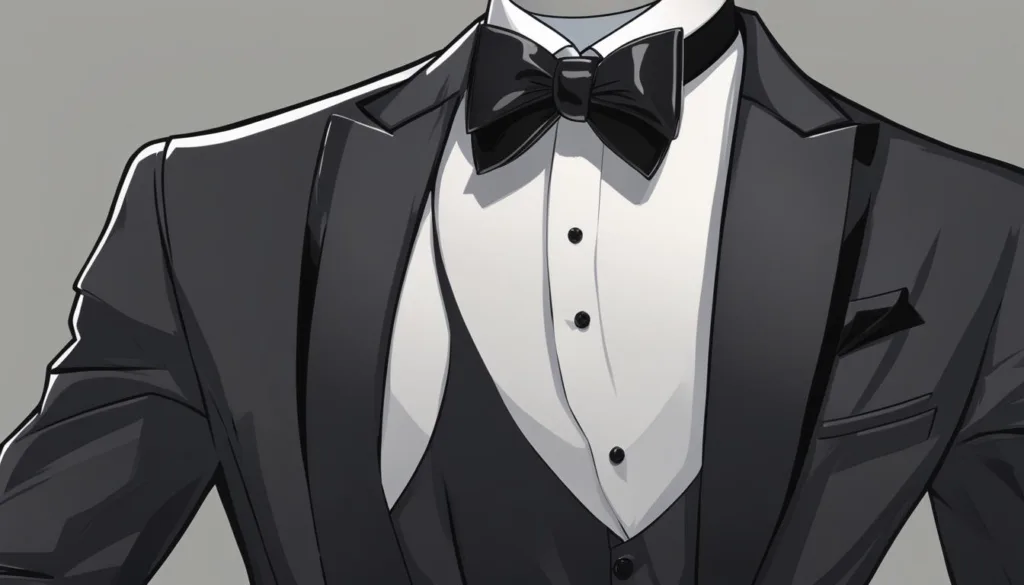
To master the traditional tuxedo dress code, it is crucial to understand the essential elements and components inherent to classic tuxedos. Abiding by the strict interpretation of black tie code is a fundamental aspect of maintaining the classic tuxedo look.
Essential Elements of Classic Tuxedos
The archetypal tuxedo design incorporates the sleekness of the black waistcoat, the sophistication of a proper turndown-collar shirt, and the stylish practicality of the cummerbund for temperate environments. In upholding this classic look, it is important to be judicious with color and accents. For instance, it is advisable to opt for a single, richly-toned accessory to maintain the ensemble’s formal integrity. Alternatives like a velvet dinner jacket demonstrate flexibility within tradition, provided that they adhere to the guiding principles of black tie elegance.
Understanding the Components of a Formal Tuxedo
Familiarity with the classic tuxedo’s components empowers one to navigate contemporary interpretations while safeguarding the celebrated decorum of the traditional black tie aesthetic. Adventurous tuxedo neckwear, colorful waistcoats, and distinct cummerbunds, while reflective of personal style, must still resonate with the poise and dignity of formal attire.
Maintaining a classic tuxedo look requires an appreciation for the various components of a formal tuxedo and how they work together. From the well-tailored jacket to the perfect fit of the trousers, each element of the ensemble plays an integral role in creating a timeless and refined appearance.
Classic Black Tie Tuxedo Styles Through the Ages
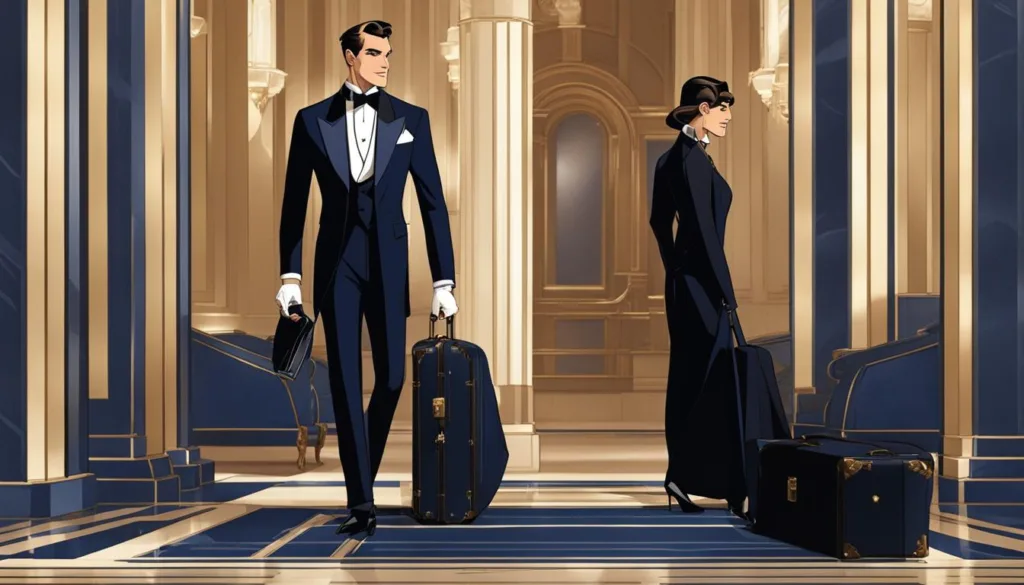
As time passed, classic black tie tuxedo styles have been both shaped and revered through various eras, exemplifying their lasting appeal and adaptability. The Depression era carved out the definitive black tie standard, moving away from earlier influences of the white tie to establish a distinct identity. Thriving through the Golden Age of Hollywood, time-honored black tuxedo styles become synonymous with grandiose cinema and celebrity culture, radiating an unprecedented level of class and charisma.
The unassailable verve of the black tie retained in these styles, as noted by GQ’s Style Guy, Glenn O’Brien, resisted the extremes of fashion trends, boasting a cache of swankiness and sophistication. Classic black tie has journeyed through the ages, absorbing and resisting transformations, ultimately preserving the hallmarks of true gentlemanly attire. The period-specific nuances have since smoothed out, leaving behind an enduring blueprint for the quintessential tuxedo that continues to command respect and admiration.
“Fashion is temporary, but style is forever.” – Glenn O’Brien
In analyzing classic black tie attire through history, particularly in the 20th century, we can identify three vintage tuxedo styles that have stood the test of time:
- 1930s – The Peak Lapel Dinner Jacket: The quintessential example of formal tuxedos, the peak lapel jacket was the height of elegance and sophistication, with sharp lines and a flattering silhouette that exuded confidence.
- 1950s – The Shawl Collar Dinner Jacket: With a more relaxed and casual vibe, the shawl collar dinner jacket saw great popularity during Hollywood’s Golden Age, as movie stars rocked the red carpet in this effortlessly stylish tuxedo.
- 1970s – The Velvet Dinner Jacket: This luxurious, plush tuxedo jacket provided an opulent alternative to the classic dinner jacket, bringing a touch of glamour to formal affairs without sacrificing the traditional black tie aesthetic.
Today, these vintage tuxedo styles continue to inspire the world of men’s fashion, proving that classic black tie attire is truly timeless.
The Impact of Vintage Influences in Tuxedo Styles

The lasting eminence of vintage influences in tuxedo styles is apparent in Art Deco elements and the imprint of the Golden Age of Hollywood. These eras introduced fascinating design elements that have become an integral part of classic fit black tie tuxedos today.
Art Deco and the Golden Age of Tuxedos
This period saw the emergence of design elements like velvet hybrids featuring silk-covered shawl collars and peaked lapels, while the smoking jacket entered the scene as a velvet-clad alternative for a more relaxed black-tie affair. Art Deco, celebrating geometric forms and elegant modernism, ushered in tuxedo styles that embraced bold yet refined lines emblematic of the period.
How Historical Events Shaped Classic Tuxedo Fashion
Historical events played a pivotal role in shaping classic tuxedo fashion, from the sumptuousness of prohibition-era parties to the austerity of wartime. Each influenced the tuxedo’s evolution into a garment that balanced tradition with practical elegance. Notably, by embracing darker, richer tones over bright or pastel shades, classic vintage style adhered to the demands of formal wear while allowing for personal expression. This legacy of historical and vintage trends reinforces the notion that while tuxedo styles may reflect their times, the most enduring pieces remain anchored in the principles of classic fit and finesse.
Classic Fit Black Tie Tuxedos: A Guide to Sartorial Elegance
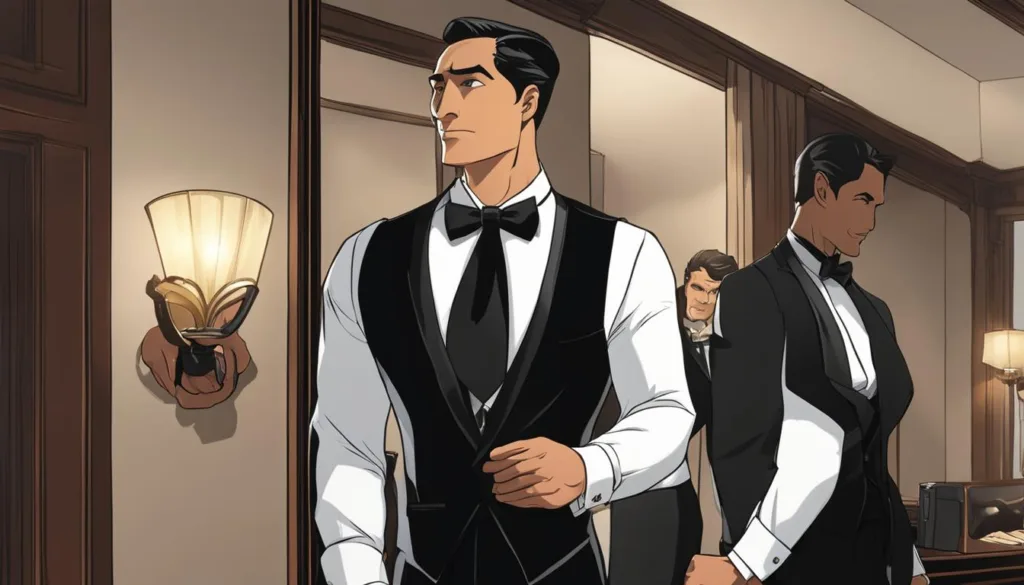
Classic fit black tie tuxedos epitomize sartorial elegance, blending traditional design with meticulous tailoring to achieve a timeless look that accentuates masculine strength and poise. Such tuxedos stand as a testament to the golden era of formal wear, with their designs meticulously refined to enhance the wearer’s appearance while projecting an air of indisputable distinction.
Renowned authors and dressmakers like Sir Hardy Amies and Alan Flusser have emphasized the importance of wearing clothes that communicate calculated selection and care, aspects that are quintessential to achieving the classic tuxedo look. With their roots deeply embedded in the sophisticated standards set during the 1930s, classic fit black tie tuxedos continue to uphold the perfection of their design, showcasing the longevity of their style in modern formal attire.
“Fashion fades, style is eternal.” – Yves Saint Laurent
Let us delve into the essential elements that define the classic fit black tie tuxedos and offer a glimpse into the world of traditional tuxedo elegance:
- Lapel Type: The choice between peaked, shawl, and notched lapels affects the overall appearance of the tuxedo. Peaked lapels, with their broad, V-shaped design, are considered the most formal option, offering a heightened sense of structure and refinement.
- Single or Double-Breasted: Single-breasted tuxedos are the standard choice for black tie events, presenting a slimming and streamlined appearance. Double-breasted tuxedos offer a more distinctive look with their overlapping front panels, lending a touch of classic charm to the ensemble.
- Trousers: Classic fit tuxedo trousers feature a high waist, straight leg, and a slimming satin stripe down the side seam, complementing the formal jacket and reinforcing the structured silhouette.
- Shirt: A crisp, white dress shirt with a wing or turndown collar lays the foundation for the classic tuxedo ensemble, ensuring the focus remains on the bow tie and the jacket’s lapels.
- Accessories: Timeless accessories such as a black silk bow tie, cummerbund or waistcoat, and polished black dress shoes contribute to the overall traditional tuxedo elegance.
Understanding and embracing these essential elements of classic fit black tie tuxedos is key to achieving a refined and ideal look for any formal occasion. As fashion trends come and go, the enduring appeal of the classic tuxedo remains a testament to the immortal charm and sophistication it embodies.
Maintaining a Classic Tuxedo Look Amidst Contemporary Trends
In a world of ever-changing fashion, it is essential to maintain a classic tuxedo look amidst contemporary trends, ensuring that the iconic attire remains elegant and sophisticated. This requires a careful balance of respect for tradition and openness to innovation, as well as an understanding of the core elements that define a classic tuxedo.
Navigating Modern Twists on Traditional Attire
Navigating modern twists on the traditional tuxedo involves recognizing the classic tuxedo’s core elements while understanding the subtle ways in which current influences can tastefully enhance or refresh the ensemble. Key to this balance is the principle that fewer accents yield a more impactful statement, as eloquently stated by sartorial authors like G. Bruce Boyer. Challenges lie in adding individualistic touches without overwhelming the refined simplicity of classic black-tie attire—such as discreet pops of color or uniquely styled dinner jackets.
Preserving the Integrity of the Classic Tuxedo Aesthetic
Preserving the integrity of the classic tuxedo aesthetic means upholding the garment’s long-standing reputation for elegance and formality. The tuxedo remains a symbol of taste and distinction in a swiftly transforming world of fashion, ensuring its enduring appeal and timelessness. By staying true to traditional tuxedo designs while skillfully navigating contemporary tuxedo styles, one can achieve a balanced and sophisticated look that continues to command respect and admiration.
Tuxedo Style for Formal Occasions: Dressing to Impress
When it comes to tuxedo style for formal occasions, the goal is not just to wear a standard suit but to dress to impress with thoughtful consideration for the event’s formality and an individual’s personal style preferences. Navigating the various elements of dressing for black tie events is an art form, requiring an ability to select the appropriate tuxedo and strategically accessorize for a cohesive, polished look.
Selecting the Right Tuxedo for Different Events
Understanding the demands of an event and discerning the nuanced differences between various tuxedo styles, such as a shawl collar or a peaked lapel, is crucial when selecting the right tuxedo for different occasions. The choice of tuxedo should reflect a balance between adhering to black tie norms and showcasing one’s personal style while maintaining an air of sophistication and elegance.
Accessorizing for a Cohesive Formal Outfit
Strategic accessorizing goes beyond the traditional black bow tie and involves pairing the tuxedo with matching cummerbunds, pocket squares, and appropriately formal footwear. Additionally, consideration should be given to the event’s timing, ensuring black-tie attire is reserved for evening occasions. Adhering to fashion authorities’ advice, true formal dressing embodies excellence through unity and harmony, with each piece of the outfit playing an intentional role in creating a classic and cohesive outfit.
The Art of a Perfectly Tailored Tuxedo
Mastering the art of a perfectly tailored tuxedo is essential for capturing the essence of black tie refinement. The process requires meticulous attention to detail, ensuring that every element, from the fit of the jacket to the drape of the trousers, is crafted to enhance the wearer’s stature. A well-tailored tuxedo jacket is the linchpin of the ensemble and should fit closely without restricting movement, with a length that offers coverage while shaping the silhouette’s form.
Tailoring extends to the trousers, which should align with the jacket’s material and feature a braid along the seam, high-waist design, and a fit that complements the jacket’s proportions. The precision of tailoring embodies the reverence for the detailed craftsmanship synonymous with classic tuxedo attire. As the symbolism of a man’s care in dressing, a perfectly tailored tuxedo showcases one’s discerning taste and commitment to traditional elegance in formal wear.
Essential measurements for a perfectly tailored tuxedo
| Measurement | Importance |
|---|---|
| Chest | Determines the jacket size and ensures a comfortable, flattering fit. |
| Waist | Guides the trouser size for a secure fit and clean, streamlined appearance. |
| Hips | Ensures that trousers fit comfortably and don’t strain through the hips. |
| Jacket Length | Controls the balance between the jacket and trousers, creating a proportional silhouette. |
| Sleeve Length | Assures that jacket sleeves are the proper length, allowing for a slight cuff display. |
| Trouser Length | Guarantees a polish finish with the correct trouser break and minimal bunching. |
By taking these measurements into consideration and working with an experienced tailor, one can achieve the traditional tuxedo elegance that is desirable for black tie events. A perfectly tailored tuxedo not only showcases a man’s commitment to style, but it also exudes an air of sophistication and poise, leaving a lasting impression on any formal occasion.
Dressing Icons: Notable Figures and Their Influence on Tuxedo Fashion
Notable figures and icons in tuxedo fashion have played a pivotal role in elevating the status and popularity of classic black tie tuxedo styles. These dressing icons have not only inspired countless admirers but have consistently brought their fashion, charisma, and allure into the limelight, forging trends in tuxedo and black tie styles.
The Role of Celebrities and Royalty in Tuxedo Popularity
Throughout history, celebrities and royalty have had an undeniable influence on the rise and continued popularity of tuxedos. Their impeccably stylish tuxedo appearances not only set trends but also added an aura of glamour and sophistication to the classic tuxedo. Prominent figures in fashion and entertainment, adorned in their stunning tuxedos, have truly cemented the tuxedo as the epitome of formal attire.
Influence of Cinema on Classic Tuxedo Trends
The silver screen has shaped tuxedo trends in countless ways, with iconic film moments capturing the magic and enigmatic allure of celebrities dressed in classic black tie tuxedo styles. Actors such as Cary Grant, in his unforgettable role in “Indiscreet,” have left an indelible impact on the fashion world and the tuxedo styles we admire today. Cinema’s influence extends beyond mere wardrobe choices and transcends into a cultural phenomenon, etching the tuxedo’s presence into the hearts and minds of generations.
Classic black tie tuxedo styles, influenced by notable figures and the cinema, embody poise, sophistication, and timelessness. It is evident that through their contributions, these icons have solidified the tuxedo as an enduring symbol of style and elegance.
Conclusion
In conclusion, classic black tie tuxedo styles have admirably stood the test of time, continuously demonstrating their enduring appeal and the unfading relevance of traditional tuxedo elegance. Recognizing and embracing the timelessness of these tuxedo styles allows one to appreciate their significance as distinctive sartorial masterpieces transmitted across generations.
Embracing the Timelessness of Classic Black Tie Tuxedos
Not only are they a testament to artistic prowess, classic black tie tuxedos embody a lifestyle characterized by a deep-rooted commitment to the principles of menswear and the value of decorum. When wearing such attire, one is not merely making a fashion statement but deliberately aligning with a rich legacy of elegance and sophistication epitomized by style icons and renowned authorities like Sir Hardy Amies, Alan Flusser, and G. Bruce Boyer.
Why the Classic Tuxedo Will Never Go Out of Style
Despite the caprice of ever-changing fashion trends, the classic tuxedo maintains its place as an immutable symbol of panache in the realm of formal attire. Rooted in historical precedence and honed over time, the classic tuxedo continues to be significant not only for its aesthetic allure but also for its relevance. As the tradition of formal occasions endures and evolves, so does the classic black tie tuxedo style, ensuring that it remains an indisputable standard of decorum and refinement, now and forever.
